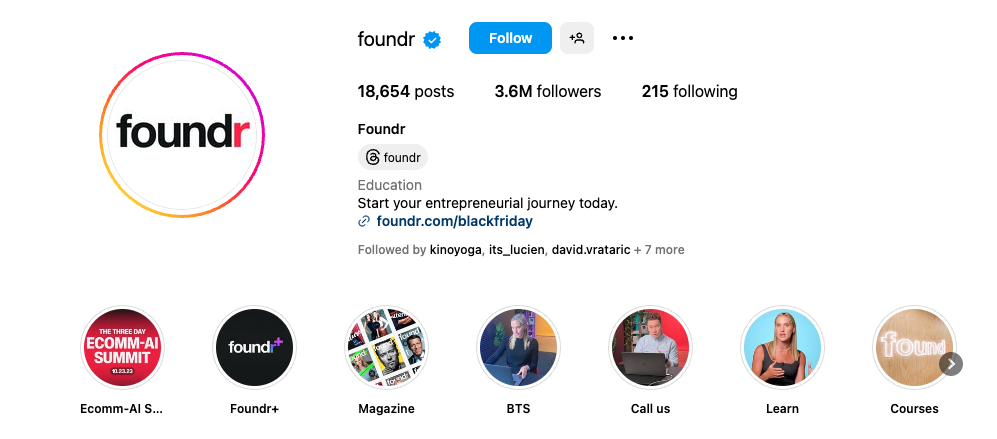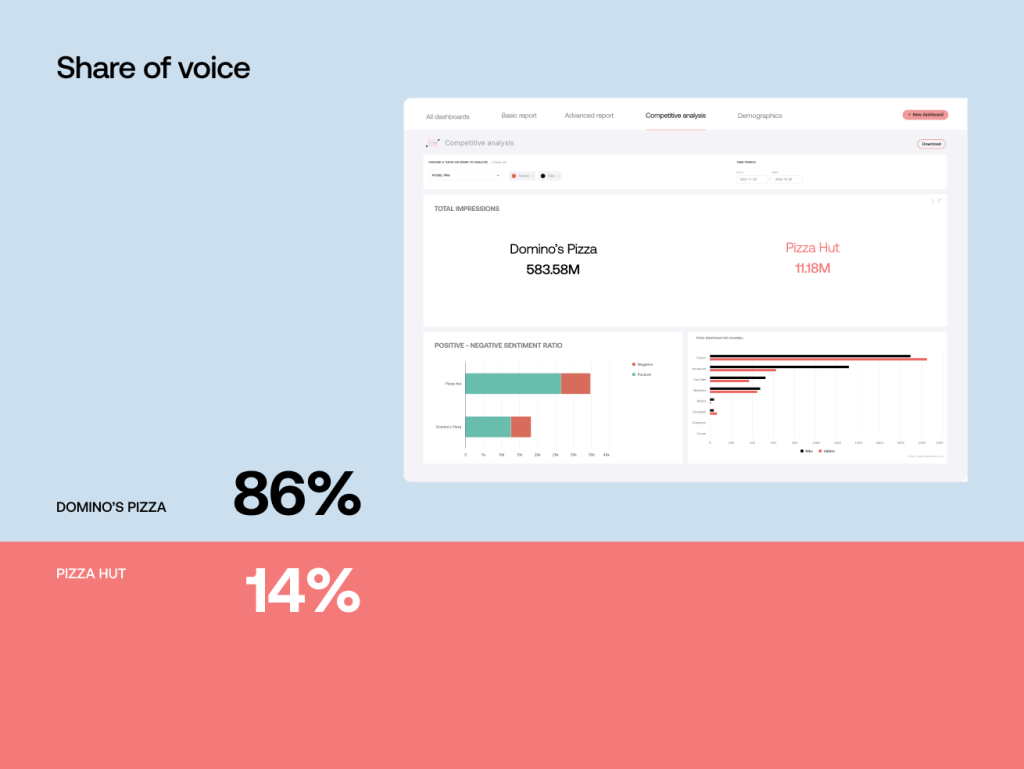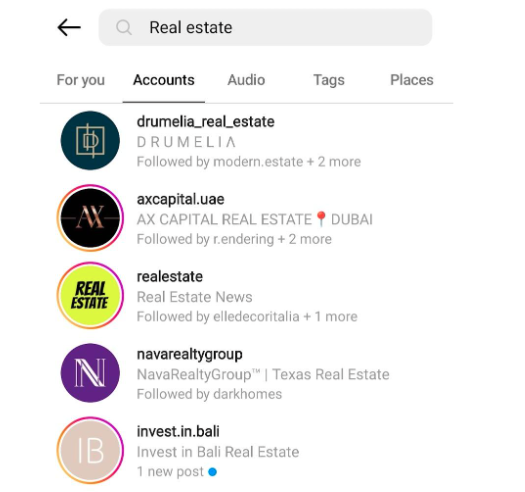Analyzing the performance of your competition on Instagram can help you discover new opportunities and develop creative campaigns that engage more users.
You can also identify trends that can help you improve your content. That can help increase brand awareness, customer loyalty, sales and revenue.
💡 Read Creating a Marketing Strategy that Works: Benefits, Steps, Tools
In this blog post, you will learn how to maximize Instagram’s potential by conducting an Instagram competitive analysis.
1. Identify Your Competitors
You want to identify your ranking competitors as part of your Instagram competitive analysis. To identify these businesses, determine your target industry and niche. Then search using relevant keywords on Instagram.
Once you have the list of your performing competitors, categorize them into any of these groups:
- Direct competitors: Businesses offering similar products or services in your target market.
- Indirect competitors: Accounts that offer products or services that may cater to your target audience or operate within your industry but don’t directly compete with you.
You can also look for inspirational accounts or industry leaders who may not be direct competitors but offer valuable insights into content strategy and potential trends.
With these categories in place, you can easily determine which social media accounts to prioritize learning about when conducting your competitor analysis. This is especially useful if you have limited resources. So, you should focus first on your direct competitors, then on your indirect competitors and, lastly, on inspirational accounts for social media benchmarking.
2. Analyze their Profiles
The next step in your analysis is to look at your competitors’ social profiles. This will give you valuable insights into how you can differentiate yourself as a business.
While evaluating your competitors’ profiles, pay close attention to these details:
- Bio: Do they have a straightforward, concise, engaging biography reflecting their brand identity? Is there something unique about their bio?
- Profile aesthetics: Is their profile photo professional and consistent with their overall branding? Are they embracing a specific theme or style?
- Website link: Do they have a link in their bio? Are they effectively using the link to drive traffic to their site or specific landing pages?
- Keywords: What keywords are they using in their profile?
This information lets you optimize your profile and improve your account performance. For instance, if your competition appears first when active users search for your niche on Instagram, you’ll want to emulate how they structure their Instagram profile and use the keywords they employ.
You might find other areas of improvement for increased conversions, too.
Here’s an example.
If you look at this profile description, you’ll notice that there’s a link in their bio, but no call to action. So, as a competitor of the company, you might want to provide a clearer call to action in your Instagram bio. This way, Instagram users are more likely to click on your link and convert:

A good profile can also spell the difference between your account getting comments and likes on Instagram or not.
3. Study Their Followers
Understanding your competitors’ followers helps you create detailed customer personas that accurately reflect your target audience. Furthermore, it can reveal gaps in your competitor’s offerings, allowing you to capitalize on these opportunities.
So, look at your competitors’ total follower count. You’ll want to determine if they have genuine or fake followers to ensure an accurate gauge of their Instagram account’s success. Just go through their follower list and look at each account as part of your Instagram competitive analysis. You might want to tag as suspicious the following:
- Accounts without images as their display photos
- Accounts with few to no followers
- Accounts with no posts
- Private accounts
- Accounts with made-up names like handles that contain many numbers
These are likely accounts that were bought to make their account seem popular. If your competitor is left with a short list of followers even after you remove these suspicious accounts, analyze why they’re faring badly. Use competitor analysis tools like Determ to determine the general sentiment on Instagram about the brand. So, if you see many Instagram users online complaining about how the brand’s customer service is bad, you’ll want to leverage this weakness and invest in training your customer service team, for instance.
If, on the other hand, your competitor has a healthy followers’ list, then you can conclude your competitor’s Instagram account is performing. So, you’ll want to use it as a model when crafting your Instagram strategy. Apart from their Instagram bio, you’ll want to check their content strategy and engagement rate so you can improve your own strategies. We’ll discuss these things later.
Don’t forget to determine the demographics of their Instagram followers you conclude are legitimate with analytics tools. Look at their gender, age, and location. These are likely your target audience, too. With this data, you can better understand their needs, motivations, and preferences so you can cater to them better.
It’s also a good idea to look through your competitors’ list of followers to determine if any influencers or other large accounts are following them. You might want to follow them, too, to increase the chances of their own followers checking out your profile. You may also seek them out for potential brand collaborations.
Read 10 Most Effective Ways To Find Instagram Influencers
4. Evaluate their Content Strategy
Content is the heart and soul of any retail or SaaS marketing strategy. It’s essential to understand your competitors’ Instagram content strategy so you can find ways to improve your own.
Observe their primary content categories (e.g., product showcases, event promotions, or customer testimonials). What types of content are there? Is there video content like Reels and Stories? Or are they just images? What content ideas can you generate from looking at their content?
Then look at user engagement. Does your competitor’s content garner many likes and shares? That means their Instagram content strategy is working and is worth emulating.
If this is the case, analyze your competitors’ top-performing content closely. This is the type of content you want to create. Look at their caption structure and the way they discuss topics as well. See how they use relevant hashtags.
For example, WSJ combines visuals and lengthy captions to generate thousands of likes. Furthermore, they do not include hashtags at the end of captions or comments. If you were a WSJ competitor, you’d do the same:

Also, identify any strategic content partnerships or collaborations by your competitors. Then, determine if these contribute to their growth, and reflect on how you can incorporate similar approaches to your strategy.
Aside from these, examine your competitors’ posting behavior. Measure the average number of posts per week, identify any posting patterns (e.g., days of the week or specific time slots), and observe seasonal patterns, such as holiday promotions or special events.
You’ll want to monitor whether any of these content types become viral so you can ride on the trend, too.
Set up Determ so that it gives you real-time notifications when there’s a spike in mentions on Instagram of your competitor. You can choose how you want to be notified, whether via email, Slack, or other channels, so that way your Instagram competitive analysis is thorough.
5. Assess Engagement with Other Instagram Users
Don’t forget to analyze how your competitors engage with other Instagram users as part of your social media strategy. You can track mentions of your competition and imitate their customer engagement strategy if it’s working for them.
How do you know if that strategy is working for them? Use Determ. The tool can help you see if public opinion is working in their favor (the positive sentiment rate should be way higher than the negative one).

Let’s say you conclude they’re doing well in the customer relations department. Then pay attention to their tone of voice when answering comments on Instagram. See whether they use emojis and long sentences, too. You’ll want to incorporate these details when interacting with Instagram users to improve your customer relations.
In Closing
Conducting an Instagram competitor analysis is a great way to help you and your brand succeed.
Read Social Listening for Instagram: What Is It And How To Do It
By taking the time to identify your competitors, analyze their profiles, study their followers, evaluate their content strategy, and assess their customer engagement, you will gain valuable insights that help inform your Instagram strategy. This can help you differentiate yourself from your competitors while remaining relatable continuously.
With an effective Instagram competitive analysis, ultimately, you can stay ahead of the curve.
Harry Flynn leads the digital marketing team at Twicsy, a site providing services to Instagram users. He enjoys traveling and relaxing with friends in his spare time.
